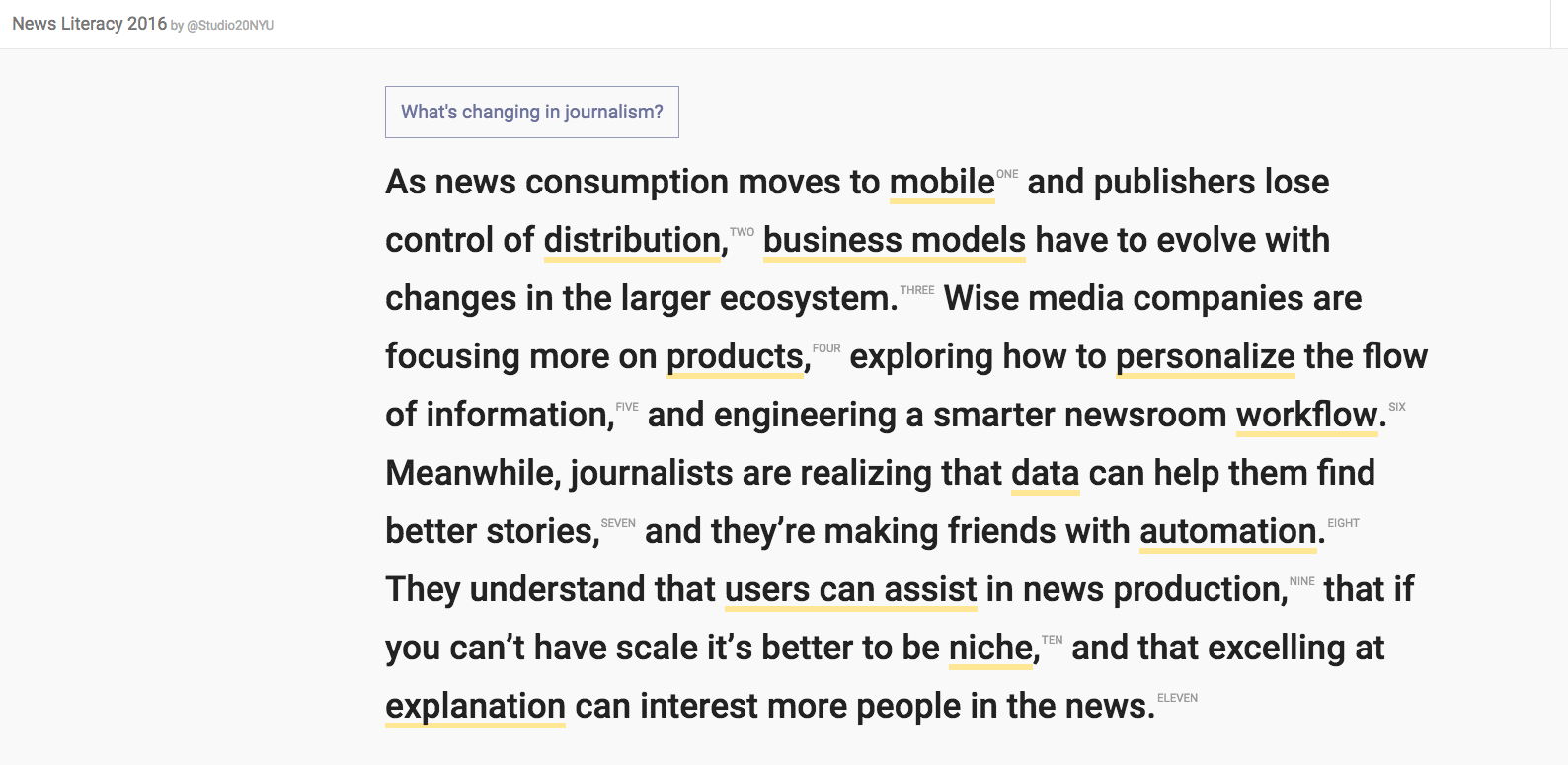You can’t start trailblazing the future of digital journalism without knowing what factors are at work disrupting the field every day.
That was Jay Rosen’s starting point with the News Literacy 2016 project, which launched March 1. The project is the work of Studio 20, a journalism master’s program at New York University, which graduated its first digital-first class of students in 2010.
The project’s impetus dates to a post on Rosen’s PressThink blog in November 2014, which was a list of topics students should master if they want to understand the way digital journalism continues to move and change, and how to help news organizations adapt to the particular requirements of the digital age.
Those influencing factors – which ranged from new business models to funding the news to personalization – were the underpinnings of News Literacy, a user-friendly resource that offers students, educators and the public a distilled, authoritative snapshot of the factors disrupting the news biz right now.
While Rosen has always given master’s students in his “digital thinking” course an overview of these forces in their first semester of the program, this marks the first year he handed the reins over to his students to make an outward-facing product for other students.
Made With The User in Mind
Across the project’s 11 topic pages written by Studio 20 students, you’ll see a read time listed at the top of each entry, a concise summary, external links for further reading and key influencers to follow on social media.
Those signposts show a student-driven project that puts the user’s needs front and center: namely, other student journalists and teachers looking for an introduction to, say, automated journalism.
While researching and presenting in class gave Studio 20 students an immersive look at the big bucket topics changing journalism, it also provided a lesson in identifying an audience and making a product tailored to their particular needs – a task that’s critical for digital journalists.
“I wanted my students to make something for journalism teachers and journalism students learning about the digital transformation of the craft and have a very clear sense of who they are trying to serve with their product,” Rosen said.
That was his hypothesis heading into the project: If you started with a good understanding of who you were trying to serve, you’d be successful in creating a useful, excellent product to serve that audience.
And so far, the work seems to have paid off.
Since its launch, Studio 20 students have heard from users around the world about how they’re using the project in classes and newsrooms, according to Kim Bode, the News Literacy project manager.
Bode said the feedback they’ve received from users as far away as New Zealand and Europe attests to the project’s resonance – and its reach far outside of the New York City media bubble.
“We realized we were having a lot of these discussions in our own peer groups, but they’re very relevant to the entire industry,” she said.
Chris Lusk, another Studio 20 student who spearheaded the design and web development side of the project, said the team worked hard to cut through the lofty buzzwords and pin these concepts to the real world.
One guiding question, according to Lusk, was: What are real people, not just journalists, using, and how can we meet them where they are?
“We wanted to take these vague, cliche terms that get thrown around and dig past that to understand what’s actually happening on the ground,” he said. “The real people who live outside of newsrooms and live outside of j-schools, what are they looking for and what are they interacting with?”
‘This Is What We Do’
Years ago, when the digital transformation of the industry was still in its infancy, Rosen says chances were good that working journalists would be unacquainted with the topics covered in News Literacy 2016.
“Now, any self-aware journalist knows their field is in a radical transformation and that the outcome is uncertain,” Rosen said. “These are not just things gurus are talking about.”

Jay Rosen. Photo by Joi Ito and used here with Creative Commons license.
Because the project attempts to capture an ever-moving target, it’s hard to estimate the shelf life of the 2016 project, but Rosen hopes to revisit the concept when a new cohort of Studio 20 students arrives this fall.
While Rosen uses words like “risky” and “highly uncertain” to describe the industry’s continual disruption, the project’s pages are unified by a distinctly optimistic tone.
This isn’t a space for gloomy prognosticating about robots taking reporters’ jobs or a click-based economy swallowing long form journalism whole. It’s a choice that speaks both to the target audience and to a broader philosophy that the industry is far from doomed if journalists see the bigger picture, understand the moving pieces and foster the skills to navigate a changing landscape.
“We’re trying to produce graduates who can help news organizations adapt to the requirements of a digital age,” Rosen said. “This is education, this is what we do — getting students excited about learning. Any way you can get people excited and motivate them to do more is a win.”
Katherine Krueger is a writer and editor in New York City. She is a breaking news reporter for Talking Points Memo and a University of Wisconsin-Madison alumna. She tweets frequently @kath_krueger.


